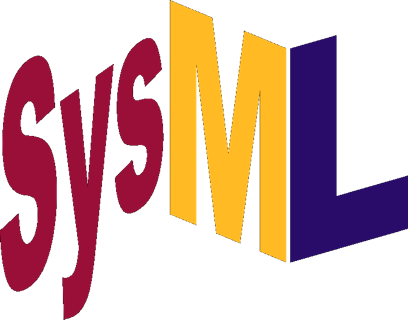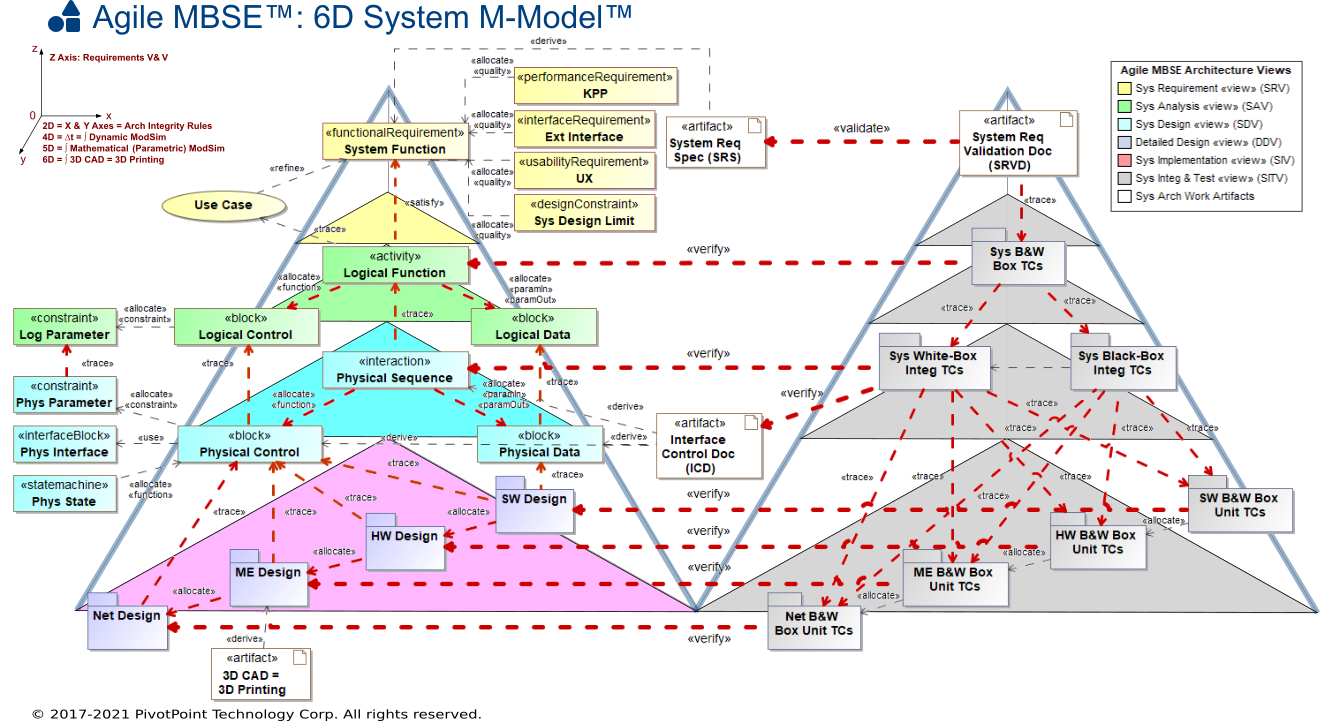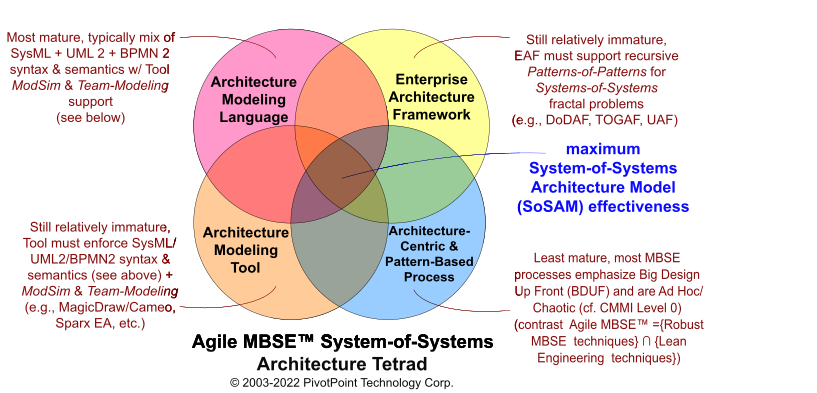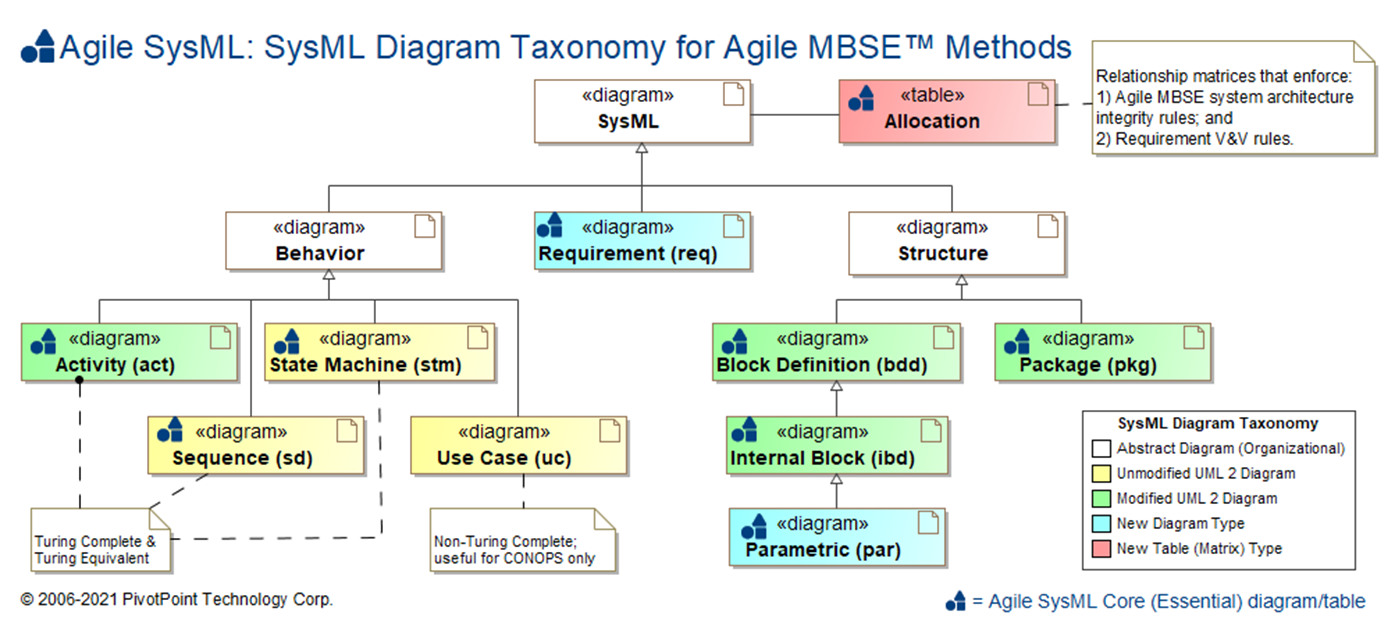MBSE + SysML Overview - What is MBSE?
MBSE Paradigm Synopsis
| Property | Description |
|---|---|
| Definition: | What is Model-Based Systems Engineering (MBSE)?Question Variant(s): What is MBSE?; What is Model-Based Systems Development (MBSD)?; What is Agile MBSE?Model-Based Systems Engineering (MBSE), a.k.a. Model-Based Systems Development (MBSD), is a Systems Engineering process paradigm that emphasizes the application of rigorous architecture modeling principles and best practices to Systems Engineering activities throughout the System Development Life Cycle (SDLC). These Systems Engineering activities include, but are not limited to, requirements analysis, functional analysis, performance analysis, system design, trade studies, system architecture specification, and system Verification & Validation (V&V). |
| Aliases: | Model-Driven Systems Engineering, Model-Based Engineering |
| Process Classification: | Engineering Process Systems Engineering Process (SEP) Model-Based SEP System Development Paradigms Model-Based Engineering Model-Based Systems Engineering |
| Core Concepts: | According to the INCOSE SEBoK (Systems Engineering Book of Knowledge) MBSE may be considered a "subset of digital engineering". |
| Process Origin: | Who created Model-Based Systems Engineering (MBSE)?Question Variant(s): Who created MBSE?Model-based specification and simulation techniques have been associated with Systems Engineering since its inception as an interdisciplinary field of engineering, which can be traced to work at Bell Telephone Laboratories and the US Department of Defense (DoD) during the 1940s (WWII). The first known public use of the term "Model-Based Systems Engineering" was by A. Wayne Wymore in his 1993 book, which used the terms as its title [Wymore 1993]. The MBSE term was also commonly used within the SysML Partners consortium during the formative years of their Systems Modeling Language (SysML) open source specification project during 2003-2005. Some SysML Partners used the term order to further differentiate SysML from its parent language UML v2, which was software-centric and associated with the term Model-Driven Development (MDD). Stated succinctly as an analogy:
The SysML Partners published the SysML 1.0 Alpha open source specification in November 2005, and the Object Management Group adopted a variation as OMG SysML 1.0 in 2006. The standardization of SysML resulted in widespread tool support for the new system architecture modeling language standard and associated MBSE processes that emphasized SysML as their lingua franca. For example, PivotPoint Technology Corp., one of the founding members of the SysML Partners, released commercial training courseware in July 2007 that featured Model-Based Systems Engineering with SysML. In September 2007, the MBSE approach was further generalized and popularized when INCOSE introduced its MBSE 2020 Vision, which was not restricted to SysML, and supported other competitive modeling language standards, such as AP233, HLA, and Modelica. According to the MBSE 2020 Vision: "MBSE is expected to replace the document-centric approach that has been practiced by systems engineers in the past and to influence the future practice of systems engineering by being fully integrated into the definition of systems engineering processes." According to the INCOSE SEBoK (Systems Engineering Book of Knowledge) MBSE may be considered a "subset of digital engineering". |
| Current Specification: | OMG SysML v. 1.6 (See SysML.org Specifications page.) |
| Process Characteristics: | • General purpose? • Promotes open standards? • Rigorous? • Scaleable? • Supports Agile or Lean processes? • Automated tool support? [Can be applied to any System or System-of-Systems] [Not rigorously enforced, but encouraged] [Must be applied in a rigorous manner.] [Can scale for projects with 100+ engineers.] [Must be adapted for Agile + Lean methods.] [Must select MBSE modeling tool that supports automation.] |
| Enabling Technologies: | • Model-Based Languages: SysML, OMG SysML, UML 2 … • Model-Based Architecture Frameworks: DoDAF, UPDM, ... • Model-Based Tools: See MBSE Tools section. |
| Process Usages: | • Primary Users: Systems Engineers • Other Users: Software Engineers, Electrical Engineers, Mechanical Engineers, Aerospace Engineers, Nuclear Engineers, Naval Engineers, … • Estimated Number of Users: N/A |
| Process Variations: | Agile MBSE, Unified Process & variants (Open Unified Process, Rational Unified Process, ...), Harmony-SE, OOSEM, … |
| Tool Support: | See MBSE Tool Reviews for selected reviews of popular SysML-compliant architecture modeling tools that support MBSE applications. |
TOGAF and ARCHIMATE are trademarks of The Open Group.
ENTERPRISE ARCHITECT is a trademark of Sparx Systems Pty Ltd. MAGICDRAW and CAMEO are trademarks of No Magic, Inc. RATIONAL RHAPSODY is a trademark of IBM.
All other trademarks are the property of their respective owners.





